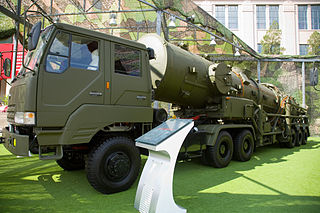 W
WA medium-range ballistic missile (MRBM) is a type of ballistic missile with medium range, this last classification depending on the standards of certain organizations. Within the U.S. Department of Defense, a medium-range missile is defined by having a maximum range of between 1,000 and 3,000 kilometres. In modern terminology, MRBMs are part of the wider grouping of theatre ballistic missiles, which includes any ballistic missile with a range of less than 3,500 kilometres (2,200 mi).
 W
WAgni-II, is the second strategic ballistic missile of Agni (missile) family envisaged to be the mainstay of the Indian missile-based strategic nuclear deterrence. The Agni-II is a medium-range ballistic missile (MRBM) with two solid fuel stages and a Post Boost Vehicle (PBV) integrated into the missile's Re-entry Vehicle (RV). The Agni's manoeuvring RV is made of a carbon-carbon composite material that is light and able to sustain high thermal stresses of re-entry, in a variety of trajectories. The Agni-IIA is a more advanced version of Agni-II, albeit with more sophisticated and lighter materials, yielding a better range and operating regime. Agni-IIA was later renamed as Agni-IV plugging the gap between Agni-II and Agni-III. While the first test of Agni-IV in December 2010 was a failure, the second test flight in November 2011 was a success Agni-II, developed as part of medium- and long-range Agni series of missile systems, has already been inducted into the Armed Forces.
 W
WAlfa was the designation of an Italian ballistic missile program that started in 1971 under the control of the GRS. It was related to the Polaris A-3 missile.
 W
WThe Dong-Feng 21 (DF-21; NATO reporting name CSS-5 - Dong-Feng is a two-stage, solid-fuel rocket, single-warhead medium-range ballistic missile in the Dong Feng series developed by China Changfeng Mechanics and Electronics Technology Academy. Development started in the late 1960s and was completed around 1985–86, but it was not deployed until 1991. It was developed from the submarine-launched JL-1 missile, and is China's first solid-fuel land-based missile. The U.S. Department of Defense in 2008 estimated that China had 60-80 missiles and 60 launchers; approximately 10-11 missiles can be built annually.
 W
WThe Ghadr-110 is a medium-range ballistic missile designed and developed by Iran. The missile has a range of 1,800 km to 2,000 km. The Iranian Armed Forces first displayed the missile to the public at an annual military parade to mark the Iran–Iraq War.
 W
WThe Khorramshahr, named after the city of Khorramshahr in Iran, is a medium-range ballistic missile that was tested by Iran in January 2017. Its range is between 1,000–2000 km with a 1,800 kg warhead and is 13 m in length.
 W
WThe Redstone rocket was named for the Redstone Arsenal in Huntsville, Alabama where it was developed. The Redstone family of rockets consisted of a number of American ballistic missiles, sounding rockets and expendable launch vehicles operational during the 1950s and 1960s. The first member of the Redstone family was the PGM-11 Redstone missile, from which all subsequent variations of the Redstone were derived. The Juno 1 version of the Redstone launched Explorer 1, the first U.S. orbital satellite in 1958 and the Mercury-Redstone variation carried the first two U.S. astronauts into space in 1961.
 W
WSedjil is an Iranian air-to-air missile, which is a "guided semiconductor radar", made in Islamic Republic of Iran Air Force ; which is in truth the changed-user of ground-to-air missile of HAWK. Sedjil's weight is approximately 500 kg, its length is 5 meters and its diameter is about 40 cm. The effective range of the missile is approximately 90 km. Its speed is estimated to be about 4-5 mach.
 W
WThe Shahab-3 is a quad-exhaust liquid-propelled medium-range ballistic missile (MRBM) developed by Iran and based on the North Korean Nodong-1. The Shahab-3 has a range of 1,000 kilometres (620 mi); a MRBM variant can now reach 2,000 kilometres (1,200 mi). It was tested from 1998 to 2003 and added to the military arsenal on 7 July 2003, with an official unveiling by Ayatollah Khamenei on July 20. With an accuracy of 140 m CEP, the Shahab-3 missile is primarily effective against large, soft targets. Given the Shahab-3’s payload capacity, it would likely be capable of delivering nuclear warheads. According to the IAEA, Iran in the early 2000s may have explored various fuzing, arming and firing systems to make the Shahab-3 more capable of reliably delivering a nuclear warhead.